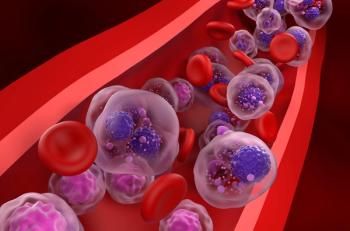
Analysis Reveals Novel CLL Subgroups
Key Takeaways
- CLL heterogeneity is highlighted by ongoing CSR and SHM in a subset of cases, suggesting a new subdivision based on IGHV mutation levels and ongoing SHM or CSR.
- Clonal lineage analysis of IGH chain sequencing data was used to evaluate CSR and SHM in CLL and SMZL patients, revealing novel CLL subgroups.
The presence of ongoing SHM or CSR in the context of CLL may support the functionality of DNA damage repair pathways, with potential relevance to therapeutic strategies.
At the virtual scientific program of the 2020 American Society of Clinical Oncology (ASCO) Annual Meeting, researchers presented findings from a recent study that reveal the heterogeneity within chronic lymphocytic leukemia (CLL), and demonstrate ongoing class switch recombination (CSR) and B cell somatic hypermutation (SHM) in a significant subset of samples. Based on the results, the researchers suggested a subdivision of CLL that comprises a combination of immunoglobulin heavy chain (IGHV) mutation level and existence of ongoing SHM or CSR.
The researchers applied clonal lineage analysis of IGH chain sequencing data to evaluate CSR and SHM in patients with CLL and patients with splenic marginal zone lymphoma (SMZL).
SHM and CSR both require the targeted generation and repair of single and double strand DNA breaks. The presence of ongoing SHM or CSR in the context of CLL may also support the functionality of DNA damage repair pathways, with potential relevance to therapeutic strategies involving the generation of DNA breaks or inhibition of DNA repair machinery.
The researchers used multiplex primers to target the IGH framework 1 region and isotype region for IGH sequencing via the Ion Gene Studio S5 from 25ng peripheral blood total RNA, which was derived from 63 patients with CLL and 4 patients with SMZL.
In order to perform the clonotyping and clonal lineage analysis, Ion Reporter was used. For the analysis, clonal lineages were defined as sets of unique rearrangements that share a variable and joining gene, with the same CDR3 length, and a minimum CDR3 nucleotide similarity of 85%. Additionally, ongoing CSR was defined as the presence of IgM/IgD and at least 1 switched isotype (IgG, IgA, or IgE), or a combination of switched isotypes, within the same lineage, while ongoing SHM was defined as the existence of subclones that differ within the VDJ region sequence in comparison to other clonal lineage members.
The analysis showed that 11 of 68 cases had evidence of ongoing CSR or SHM. For the 57 cases that did not show evidence of ongoing CSR or SHM, the variable gene mutation analysis demonstrated the existence of 3 distinct subgroups that have either no SHM, intermediate SHM (average 98% sequence identity), or high SHM (< 94% identity). Furthermore, 3 of 4 SMZL cases presented evidence of ongoing CSR or SHM.
Due to the differences observed within patients with CLL, the researchers noted the subdivision of CLL that comprises a combination of IGHV mutation level and existence of ongoing SHM or CSR may provide a criterion that supports the stratification of patients with CLL in the future.
REFERENCE
Looney T, Quest G, Feilotter H, et al. Clonal lineage analysis of CLL research samples by IGH chain sequencing to reveal novel CLL subgroups defined by ongoing class-switch recombination and somatic hypermutation [ASCO abstract e20001]. 2020 ASCO Virtual Scientific Program. 2020;38(suppl). https://ascopubs.org/doi/abs/10.1200/JCO.2020.38.15_suppl.e20001.
Newsletter
Stay informed on drug updates, treatment guidelines, and pharmacy practice trends—subscribe to Pharmacy Times for weekly clinical insights.






































































































































































































